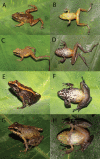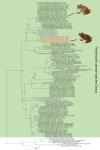A new cryptic species of terrestrial breeding frog of the Pristimantisdanae Group (Anura, Strabomantidae) from montane forests in Ayacucho, Peru
- PMID: 38161710
- PMCID: PMC10756142
- DOI: 10.3897/zookeys.1187.104536
A new cryptic species of terrestrial breeding frog of the Pristimantisdanae Group (Anura, Strabomantidae) from montane forests in Ayacucho, Peru
Abstract
Based on morphological and molecular characters, we describe a new species of terrestrial breeding frog of the Pristimantisdanae Group from montane forests of La Mar Province, Ayacucho Department in southern Peru, at elevations from 1200 to 2000 m a.s.l. The phylogenetic analysis, based on concatenated sequences of gene fragments of 16S rRNA, RAG1, COI and TYR suggests that the new species is a sister taxon of a clade that includes one undescribed species of Pristimantis from Cusco, Pristimantispharangobates and Pristimantisrhabdolaemus. The new species is most similar to P.rhabdolaemus, which differs by lacking scapular tubercules and by its smaller size (17.0-18.6 mm in males [n = 5], 20.8-25.2 mm in females [n = 5] in the new species vs. 22.8-26.3 mm in males [n = 19], 26.0-31.9 mm in females [n = 30] of P.rhabdolaemus). Additionally, we report the prevalence of Batrachochytriumdendrobatidis (Bd) in this species.
ResumenDescribimos una nueva especie de rana terrestre de desarrollo directo del grupo Pristimantisdanae de bosques montanos procedentes de la provincia de La Mar, departamento de Ayacucho al sur de Perú con rango de distribución altitudinal entre los 1200–2000 msnm, en base a caracteres morfológicos y moleculares. El análisis filogenético basado en las secuencias concatenadas de los fragmentos de genes ARNr 16S, COI, RAG1 y TYR sugiere que la nueva especie es un taxón hermano del clado que incluye a una especie de Pristimantis no descrita de Cusco, Pristimantispharangobates y Pristimantisrhabdolaemus. La nueva especie se asemeja más a P.rhabdolaemus; de la cual difiere por la ausencia de tubérculos escapulares y su menor tamaño corporal (17.0–18.6 mm en machos [n=5], 20.8–25.2 mm en hembras [n=5] en la nueva especie vs 22.8–26.3 mm en machos [n=19], 26.0–31.9 mm en hembras [n=30] de P.rhabdolaemus). Adicionalmente, reportamos la prevalencia de Batrachochytriumdendrobatidis (Bd) en esta especie de Terrarana.
Keywords: Bosques montanos; Chytridiomycosis; cryptic species; especies crípticas; filogenia; montane forests; morfología; morphology; phylogeny; quitridiomicosis.
Valia Herrera-Alva, Alessandro Catenazzi, César Aguilar-Puntriano.
Conflict of interest statement
The authors have declared that no competing interests exist.
Figures








Similar articles
-
Pristimantis antisuyu sp. n. and Pristimantis erythroinguinis sp. n., two new species of terrestrial-breeding frogs (Anura, Strabomantidae) from the eastern slopes of the Andes in Manu National Park, Peru.Zootaxa. 2018 Mar 13;4394(2):185-206. doi: 10.11646/zootaxa.4394.2.2. Zootaxa. 2018. PMID: 29690369
-
A new species of Andean frog of the genus Phrynopus (Anura: Strabomantidae) from southeastern Peru.Zootaxa. 2023 May 22;5293(2):333-348. doi: 10.11646/zootaxa.5293.2.7. Zootaxa. 2023. PMID: 37518481
-
Pristimantis achupalla sp. n., a new minute species of direct-developing frog (Amphibia, Anura, Strabomantidae) inhabiting bromeliads of the montane forest of the Amazonian Andes of Puno, Peru.PeerJ. 2021 Sep 23;9:e11878. doi: 10.7717/peerj.11878. eCollection 2021. PeerJ. 2021. PMID: 34631306 Free PMC article.
-
Noblella thiuni sp. n., a new (singleton) species of minute terrestrial-breeding frog (Amphibia, Anura, Strabomantidae) from the montane forest of the Amazonian Andes of Puno, Peru.PeerJ. 2019 Apr 23;7:e6780. doi: 10.7717/peerj.6780. eCollection 2019. PeerJ. 2019. PMID: 31065457 Free PMC article.
-
A new species of terrestrial-breeding frog (Amphibia, Craugastoridae, Pristimantis) from high elevations of the Pui Pui Protected Forest in central Peru.Zookeys. 2017 Mar 7;(660):17-42. doi: 10.3897/zookeys.660.11394. eCollection 2017. Zookeys. 2017. PMID: 28794672 Free PMC article.
References
-
- Aguilar C, Wood Jr PL, Cusi JC, Guzman A, Huari F, Lundberg M, Mortensen E, Ramirez C, Robles D, Suarez J, Ticona A, Vargas VJ, Venegas PJ, Sites Jr JW. (2013) Integrative taxonomy and preliminary assessment of species limits in the Liolaemuswalkeri complex (Squamata, Liolaemidae) with descriptions of three new species from Peru. ZooKeys 47(364): 47–91. 10.3897/zookeys.364.6109 - DOI - PMC - PubMed
-
- Berger L, Speare R, Daszak P, Green DE, Cunningham AA, Goggin CL, Scolombe R, Ragan MA, Hyatt AD, McDonald K, Hines HB, Lips KR, Maranteli G, Parkes H. (1998) Chytridiomycosis causes amphibian mortality associated with population declines in the rain forests of Australia and Central America. Proceedings of the National Academy of Sciences of the United States of America 95(15): 9031–9036. 10.1073/pnas.95.15.9031 - DOI - PMC - PubMed
LinkOut - more resources
Full Text Sources
